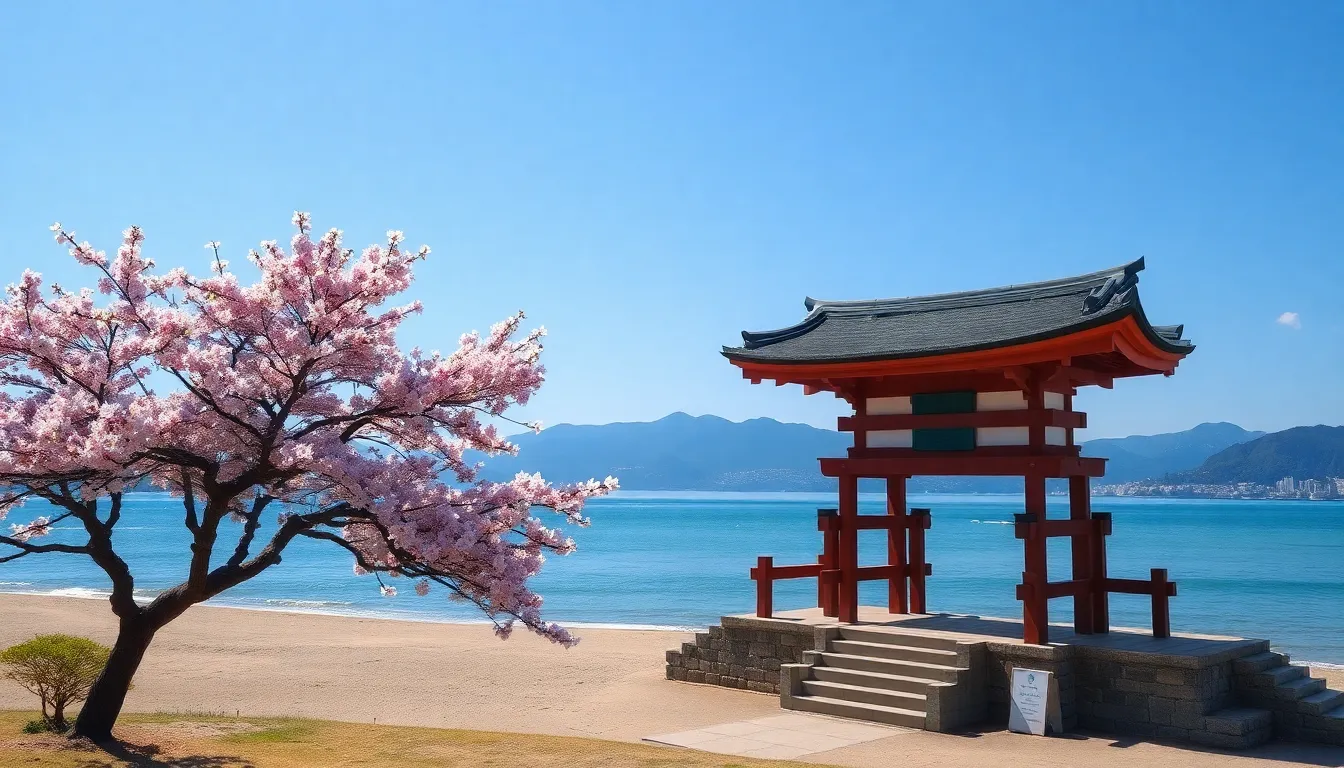Table of Contents
ToggleNestled between Japan and Korea, Tsushima Island is a hidden gem that inspires creativity and tranquility. With its stunning landscapes and rich cultural heritage, it serves as the perfect backdrop for haiku enthusiasts seeking inspiration. Each corner of the island offers a unique scene, inviting poets to capture fleeting moments in verse.
From serene beaches to lush forests, Tsushima’s diverse environments create a tapestry of experiences. Whether it’s the sound of waves lapping against the shore or the rustle of leaves in the wind, these natural wonders evoke emotions that resonate deeply in haiku. Exploring these locations not only enriches the poetic journey but also fosters a deeper connection with the island’s enchanting beauty.
Overview of Tsushima Haiku Locations
Tsushima Island offers several noteworthy locations ideal for haiku creation. Each site reflects the island’s unique beauty.
- Tachido Beach: This serene beach features fine sands and gentle waves, providing a tranquil setting for inspiration. The sunset views invite poets to capture fleeting moments.
- Tsuji Waterfall: Surrounded by lush greenery, this waterfall creates a soothing atmosphere. The sound of cascading water enhances the connection to nature, perfect for deep reflection.
- Sakura Hill: Famous for its cherry blossoms, Sakura Hill attracts visitors in spring. The vibrant blooms evoke feelings of transience, making it a perfect site for writing haiku.
- Mitsushima Harbor: This picturesque harbor boasts stunning views of fishing boats against a backdrop of distant mountains. The gentle rhythm of the water encourages creativity and observation.
- Tsushima Nature Park: Home to diverse flora and fauna, the park offers multiple trails for exploration. The varied landscapes and quiet paths foster an intimate experience, enhancing poetic expression.
These locations not only serve as scenic spots but also encapsulate the essence of Tsushima, making them ideal for capturing the soul of haiku. Each location encourages a deeper connection to the island’s natural beauty and cultural heritage.
Historical Significance

Tsushima Island holds a significant place in Japanese history and culture, influencing various artistic expressions, including haiku poetry. The island has served as a crossroads between Japan and Korea, fostering a unique blend of cultural elements.
Cultural Background
Tsushima’s strategic location has shaped its cultural narrative, evidenced by ancient trade routes and historical interactions between nations. The island’s rich history includes influences from both Japanese and Korean traditions, which manifest in local customs, arts, and literature. Cultural festivals celebrate this heritage, attracting visitors and promoting a deeper appreciation for the island’s legacy. These cultural facets provide a profound backdrop for haiku poetry, where nature and historical context inspire emotional reflection.
Influence on Haiku Poetry
Haiku poetry thrives on the fleeting beauty of nature, capturing moments that resonate with readers. Tsushima’s varied landscapes and historical context contribute significantly to this art form. The island’s serene beaches, vibrant cherry blossoms, and tranquil waterfalls evoke emotions that align perfectly with haiku’s essence. Local poets draw on the island’s history, weaving narratives that reflect both the past and the present. This connection enriches the haiku experience, allowing writers to articulate feelings that stem from their surroundings while honoring the island’s cultural significance.
Top Tsushima Haiku Locations
Tsushima Island offers numerous locations ideal for crafting haiku, each steeped in natural beauty and cultural resonance. Here are three prime spots that inspire poets to capture fleeting moments in verse.
Location 1: Tachido Beach
Tachido Beach features soft sands and gentle waves, making it a serene environment for poetic reflection. This location shines during sunset, with vibrant colors painting the sky. Poets can find inspiration in the rhythm of the tides, evoking emotions that enhance their haiku.
Location 2: Tsuji Waterfall
Tsuji Waterfall, surrounded by lush vegetation, creates a tranquil atmosphere perfect for introspection. The sound of cascading water provides a calming backdrop, inviting writers to connect deeply with their thoughts. The enchanting scenery captures the essence of nature, often translating into powerful haiku expressions.
Location 3: Sakura Hill
Sakura Hill, famous for its blooming cherry blossoms, embodies the concept of transience that haiku often captures. In spring, poets gather here to write and reflect on the fleeting beauty of the blossoms. The vibrant pink petals and the passage of time inspire poignant verses, making it a perfect spot for haiku writers.
Visitor Experience
Visiting Tsushima Island offers a unique blend of natural beauty and cultural depth, making it an ideal destination for haiku creation. The island’s serene environments invite reflection and inspiration, enhancing the overall experience for visitors.
Activities and Features
- Scenic walks: Explore well-maintained trails in Tsushima Nature Park, where diverse flora and fauna provide splendid vistas and tranquil settings for inspiration.
- Photography: Capture the stunning landscapes, like the colors of sunset on Tachido Beach or the delicate cherry blossoms on Sakura Hill, both perfect for framing poetic imagery.
- Cultural festivals: Engage in local festivities that celebrate heritage, providing insight into the island’s history and enriching the visitor experience through traditional arts and performances.
- Journaling spots: Find designated quiet areas in parks and at waterfalls, encouraging haiku writing in peaceful surroundings.
- Workshops: Participate in community-led poetry workshops that foster creativity and share local poetic techniques specific to Tsushima’s unique environment.
Tips for Haiku Enthusiasts
- Embrace nature: Pay attention to the subtle changes in the landscape, weather, and seasons, capturing the ephemeral essence essential to haiku.
- Observe local culture: Engage with Tsushima’s cultural heritage, reflecting on historical narratives that can inspire poetic themes.
- Use sensory details: Incorporate rich sensory experiences, like the sound of waves or the scent of blossoms, to awaken emotions and enhance imagery in poetry.
- Practice regularly: Dedicate time each day to write, refining the ability to express moments succinctly while drawing from the island’s inspirations.
- Share poems: Participate in local poetry gatherings, offering a platform to share creations and receive feedback from fellow haiku enthusiasts.
Tsushima Island stands as a hidden gem for haiku lovers seeking inspiration in nature and culture. The island’s breathtaking landscapes and rich history create an ideal environment for poetic expression. Each location offers distinct experiences that resonate deeply with the essence of haiku.
Whether it’s the serene waves at Tachido Beach or the vibrant cherry blossoms at Sakura Hill, every corner of Tsushima invites reflection and creativity. The blend of natural beauty and cultural heritage enriches the poetic journey, allowing visitors to connect with the island on multiple levels.
For those looking to deepen their haiku practice, Tsushima provides not just picturesque settings but also a community that values artistic expression. This unique combination makes Tsushima Island a must-visit destination for anyone passionate about haiku poetry.





